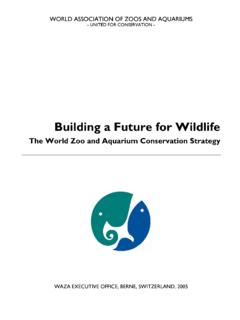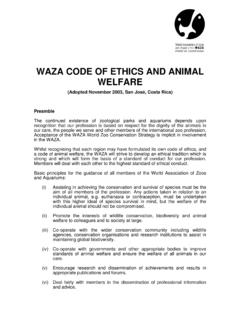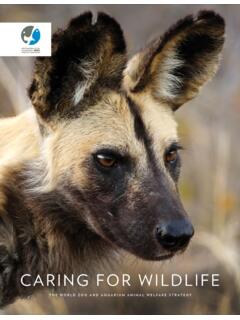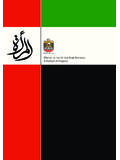Transcription of CARING FOR WILDLIFE - WAZA
1 CARING FOR WILDLIFE . THE WORLD ZOO AND AQUARIUM ANIMAL WELFARE STRATEGY. LEOPARD. TANZANIA. M I S S I O N STAT E M E N T. WAZA is the voice of a global community of zoos and aquariums and a catalyst for their joint conservation action GENERAL | Credits | Contributing Authors CREDITS. Title Copyright CARING for WILDLIFE : 2015 World Association of Zoos and Aquariums ( WAZA). The World Zoo and Aquarium Animal Welfare Strategy Citation Editors Mellor, D. J., Hunt, S. & Gusset, M. (eds) (2015) CARING for WILDLIFE : David J. Mellor, Susan Hunt & Markus Gusset The World Zoo and Aquarium Animal Welfare Strategy. Gland: WAZA. Executive Office, 87 pp. Publisher World Association of Zoos and Aquariums ( WAZA) Executive Office, Gland, Switzerland WAZA Executive Office IUCN Conservation Centre Layout and Design Rue Mauverney 28.
2 Megan Farias, Houston Zoo, TX, USA CH-1196 Gland Switzerland Cover Photography African wild dog (Lycaon pictus) | Jonathan Heger Yellow mongoose (Cynictis penicillata) | Nicole Gusset-Burgener Print Chas. P. Young, Houston, TX, USA ISBN. 978-2-8399-1695-0. C O N T R I B U T I N G AU T H O R S. Nicolas de Graaff Vicky Melfi Zoo and Aquarium Association Australasia (ZAA) Executive Office, Taronga Conservation Society Australia, Mosman, NSW 2088, Australia Mosman, NSW 2088, Australia David J. Mellor Markus Gusset Animal Welfare Science and Bioethics Centre, Institute of Veterinary, World Association of Zoos and Aquariums ( WAZA) Executive Office, Animal and Biomedical Sciences, Massey University, Palmerston North 1196 Gland, Switzerland 4442, New Zealand J lia Hanuliakov Dave Morgan Zoo Design Inc, Seattle, WA 98115, USA Wild Welfare, Groot Marico 2850, South Africa Heribert Hofer Andrea Reiss Leibniz Institute for Zoo and WILDLIFE Research (IZW ), Zoo and Aquarium Association Australasia (ZAA) Executive Office, 10315 Berlin, Germany Mosman, NSW 2088, Australia Carolyn Hogg Stephen van der Spuy Zoo and Aquarium Association Australasia (ZAA) Executive Office, Southern African Foundation for the Conservation of Coastal Birds Mosman, NSW 2088, Australia (SANCCOB)
3 , Cape Town 7441, South Africa Geoff Hosey Jason V. Watters Biology, University of Bolton, Bolton BL3 5AB, UK San Francisco Zoological Society, San Francisco, CA 94132, USA. Susan Hunt Zoological Parks Authority, Perth Zoo, South Perth, WA 6151, Australia Terry L. Maple Departments of Biological Sciences and Psychology, Honors College, Florida Atlantic University, Boca Raton, FL 33431, USA and Jacksonville Zoo & Gardens, Jacksonville, FL 32218, USA. A N I M A L W E L F A R E S T R AT E G Y | W O R L D A S S O C I AT I O N O F Z O O S A N D A Q U A R I U M S 4. TA B L E O F C O N T E N T S. GENERAL. 0 4 | Credits & Contributing Authors 10 | Recommendations 0 6 | Fo re w o rd 12 | Preface 07 | Supporting Statements 14 | Introduction 09 | Executive Summary 18. C h a p t e r 1 : A n i m a l We l f a r e a n d i t s A s s e s s m e n t 26.
4 C h a p t e r 2 : M o n i t o r i n g a n d M a n a g e m e n t o f A n i m a l We l f a r e 34. Chapter 3: Environmental Enrichment 40. Chapter 4: Exhibit Design 46. Chapter 5: Breeding Programmes and Collection Planning 54. C h a p t e r 6 : C o n s e r v a t i o n We l f a r e 60. C h a p t e r 7 : A n i m a l We l f a r e R e s e a r c h 66. C h a p t e r 8 : Pa r t n e r s h i p s i n A n i m a l We l f a r e 72. Chapter 9: Engagement and Interactions with Visitors APPENDIX. 76 | Bibliography 84 | WA Z A Co d e o f Et h i c s a n d A n i m a l We l f a r e 8 2 | A c r o n y m s a n d We b s i t e s 86 | Photography Credits 8 2 | G l o s s a r y o f Te r m s Printed with soy-based inks on 100% post-consumer waste recycled paper Translucent sheets made with 30% post-consumer waste recycled paper G E N E R A L | Fo r e w o r d In reading the World Zoo and Aquarium Animal Welfare Strategy, I was struck by how it fits in the historical development of ethical concerns for animals.
5 These concerns can be seen as falling roughly into three stages. First, in the 1700s and 1800s, at a time when blood sports and blatant acts of cruelty remained common and perfectly legal, reformers sought to stamp out cruelty as part of a broader programme of social progress. This led to the criminalising of deliberate cruelty and the banning of recreations such as bull-baiting and dog-fighting in many countries. Then during the 1900s, with the large-scale institutionalised use of animals in food production and biomedical research, the key problem of animal ethics was perceived not as acts of cruelty, but as the use of animals for utilitarian purposes in ways that resulted in deprivation and curtailment of their freedom. This gave rise to radical ideas, such as animal rights and animal liberation, which opposed all ownership and use of animals.
6 It also gave rise to concerns about the welfare or quality of life' of animals in human care, and to a combination of scientific and philosophical attempts to understand what constitutes a good life for animals. In the current century, although cruelty persists, and although huge numbers of animals continue to be used for food and other purposes, we have arguably moved into a third stage. We now see that the burgeoning human population is having vast, unintended effects on the non-human inhabitants of the planet. We affect animals by destroying their habitat, polluting their environment, introducing invasive species into their ecological systems, building structures in flight-paths, tilling the land, cut- ting trees, driving cars, burning fuel, and on and on. To date, much of the discussion of these issues has focused on conservation', which deals at the level of populations and species.
7 However, we now recognise that these same human activities cause harm to individual animals on a vast scale, making these activities a major concern for the welfare of individuals as well as conservation of species and populations. Historically, there has been a lack of communication between the conservation and animal welfare movements, and even occasional conflicts. For one thing, conserva- tion was often championed by people who wanted to preserve wild populations for activities, especially hunting and fishing, that were questioned by animal welfarists and opposed by liberationists. And conservation-oriented activities such as pest control and the reintroduction of animals often resulted in harms to the animals involved. Clearly, however, in a century when so many human activities lead to both conservation and animal welfare problems, there are far more shared concerns between the two fields than there are differences.
8 What is needed is a mentality and plan of action that will combine the momentum of both conservation and animal welfare to confront their common problems. Zoos and aquariums play important and complex roles in this arena. On the one hand, they are opposed in principle by animal liberationists, if only because they hold ani- mals in captivity'. Secondly, they are a focus of animal welfare concern because they can provide either good or bad quality of life for their resident animals, depending on the species, the staff and the institution. Good institutions have responded to these concerns with programmes of research, innovation and monitoring designed to improve the welfare of animals in their care. Thirdly, many zoos and aquariums engage in conservation activities; if these are chosen and executed with animal welfare in mind, they have the potential to enhance the welfare of wild animals as well as helping to conserve species and populations.
9 Finally, zoos and aquariums communicate with large numbers of people and thus have the potential to sensitise and mobilise people to act in ways that support both the welfare and conservation of free-living animals. The World Zoo and Aquarium Animal Welfare Strategy is a significant and timely milepost. It responds to concerns over the welfare of zoo and aquarium animals by providing a structured approach for assessing and managing animal welfare through accreditation, staff awareness, exhibit design and environmental enrichment. But it goes further by incorporating animal welfare into the conservation activities of zoos and aquariums, such as breeding programmes and programmes for the reintroduc- tion of animals into the wild. It also includes animal welfare in the public communication activities of zoos and aquariums, and thus encourages institutions to help the public appreciate the need to protect free-living WILDLIFE for both conservation and animal welfare purposes.
10 Society has few institutions that make the welfare of wild animals a key concern. By following the World Zoo and Aquarium Animal Welfare Strategy, zoos and aquariums can fill a much-needed role. Professor David Fraser Animal Welfare Program, University of British Columbia, Vancouver, BC, Canada A N I M A L W E L F A R E S T R AT E G Y | W O R L D A S S O C I AT I O N O F Z O O S A N D A Q U A R I U M S 6. GENERAL | Supporting Statements CARING FOR WILDLIFE . International Fund for Animal Welfare (IFAW). The World Zoo and Aquarium Animal Welfare Strategy makes impressive reading. It is clear that considerable thought has gone into its preparation and the animal welfare principles and recommendations are well researched and thorough. Whilst IFAW believes that WILDLIFE belongs in the wild, we recognise that wild animals are kept in human care for a variety of reasons.












